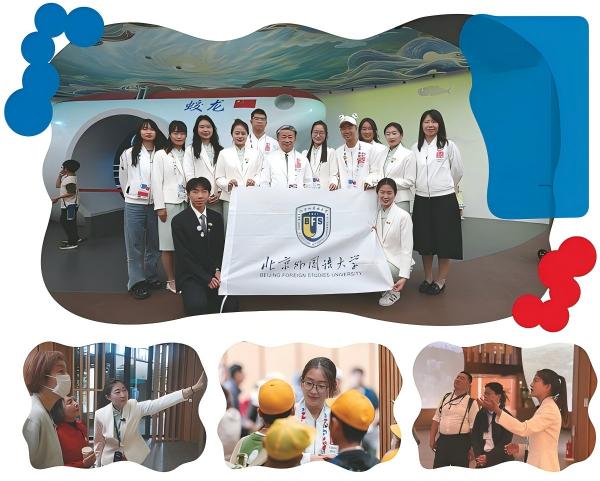Heartbeats sync and stories unfold as volunteers bring a shared human spirit to life at one of the world's biggest cultural gatherings.

Dong Weiqian was only 8 when the Shanghai World Expo was held in 2010. He didn't get the chance to visit — and has always regretted it.
Over the years, he closely followed the 2015 Milan World Expo and the 2020 Dubai World Expo, and attending the event became a dream he was determined to fulfill.
"I've always loved connecting with people from different backgrounds," he said. "I believe these interactions allow me to see the world from perspectives I might never have considered otherwise."
Now 22 and a senior majoring in Japanese at Beijing Foreign Studies University (BFSU), Dong finally realized his dream by being selected as one of 60 volunteers for the Beijing Volunteer Service Group to the Osaka World Expo.
The group was jointly recruited by the Beijing Municipal Committee of the Communist Youth League and the Beijing Volunteer Service Federation, with selection organized by the China Council for the Promotion of International Trade.
READ MORE: Osaka Expo sees Guizhou in full bloom
The first cohort of 20 volunteers, drawn from 12 universities, departed for Japan on April 2 and completed their two-month service on June 6. Among them were nine students from BFSU.
During their time in Osaka, Dong and his schoolmates worked in the protocol team, helping guide guests through the China Pavilion.
For 25-year-old volunteer Wu Yuxi, the Expo's cultural diversity left a deep impression. She observed how each country's pavilion presented a unique reflection of its identity.
"The China Pavilion highlighted our 5,000-year cultural heritage, while the Japan Pavilion stood out for its elegance and attention to detail. The France Pavilion centered around love, and the US Pavilion showcased cutting-edge space technology," she said.
One exhibit in the China Pavilion particularly moved her: Gengzhitu (Illustrations of Tilling and Weaving) from the Song Dynasty (960-1279), considered the world's earliest agricultural encyclopedia.
Originally 46 pages long, it had been transformed into a five-page animation using modern technology.
"It was a powerful example of how digital tools can help bring Chinese history to life for a global audience," she said.
Dong was struck by how curious and respectful visitors were. He noticed their genuine interest in every display.
ALSO READ: Japan sees 3.91 million foreign visitors in April, hitting monthly record
"Even when they encountered something familiar — like the "24 solar terms", which also exist in Japanese culture — they didn't take it for granted. Instead, they were excited to see the cultural connections between the two countries," he said.
Zhang Jingyuan, 24, a Japanese interpreting major, shared how small interactions could spark meaningful bonds. She was surprised by how many visitors could identify specific pandas in China and even recall their names.
"When I greeted them with a panda model in hand, many Japanese visitors expressed how sad they were that pandas are no longer in Japan," she said, touched by the strong connection people have with these iconic Chinese symbols.
Learning through service
For volunteer Zhang Yuxin, the experience was as much about learning as it was about serving. Visitors often asked questions that went beyond the official scripts, prompting her to do extra research in her spare time.
"I feel like I'm representing the image of BFSU — and more broadly, the image of Chinese youth — so I really want to give it my best," she said.
The experience also brought moments of unexpected emotional depth.
ALSO READ: Growing ideas across borders
Volunteer Huang Yutong remembered guiding a Japanese professor who had come specifically to see the lunar soil samples on display. He studied the specimens — brought back from both the near and far sides of the moon — with intense focus. Moved by what he saw, he told Huang he would gladly line up again just to view them a second time.
That encounter stayed with Huang. "After giving so many tours, the work can start to feel repetitive," she said. "But seeing someone's raw emotion reminded me why it mattered. It made me feel that my role truly meant something."
Zhang Jingyuan echoed that sentiment. For her, volunteering at the Expo was unlike any previous experience.
"It's such a grand event," she said. "It gave me the chance to interact with people from all over the world and help them experience a more authentic side of China."
At the Luxembourg Pavilion, Dong experienced something that, to him, perfectly captured the spirit of the Expo. One interactive installation invited visitors to synchronize their heartbeats into a single rhythm using handheld devices. As the collective pulse echoed through the darkened theater, Dong felt a profound sense of unity.
READ MORE: Tradition without borders
"It didn't matter who you were — your race, nationality, or economic background. In that moment, everyone in that space felt something deeply human," he said.
"I believe the merging heartbeats were a metaphor for a future world where people are connected not by their differences but by a common purpose and shared destiny."
Looking back on his journey, Dong said that finally realizing his childhood dream of attending a World Expo made everything worthwhile.
"This volunteer experience opened my eyes to new possibilities," he said. "As a Japanese major, I feel more motivated than ever to keep building my skills and use them to tell compelling stories about China to the world."


